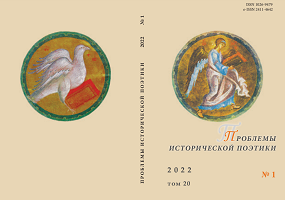Мотив иконы в повести протоиерея Николая Агафонова «Стояние»
The Icon Motif in “Standing , а Short Novel (‘Povest’)” by Archpriest Nikolai Agafonov
Author(s): Ivan S. Leonov, Dorota WalczakSubject(s): Christian Theology and Religion, Russian Literature, Culture and social structure , Eastern Orthodoxy
Published by: Петрозаводский государственный университет
Keywords: Orthodox fiction; missionary prose; Archpriest Nikolai Agafonov; short novel (‘povest’); motif; icon;
Summary/Abstract: The article is devoted to the study of the role of the icon motif in “Standing,” a short novel (‘povest’) by Archpriest Nikolai Agafonov. The authors analyze the features of the work that allow to categorize it as Orthodox fiction: the spiritual evolution of the characters, the search for the Creator, the appeal to the Church, the moral crisis and overcoming this crisis. In addition, portrayal of the miracle is analyzed along with a wide range of reactions of the characters who witnessed the incident. The Kuibyshev miracle is considered in the historical, cultural and literary contexts: the characteristics of the era are investigated, a connection is established between “Standing” by Nikolai Agafonov and other works of art dedicated to this event. There is also an undeniable ideological and artistic similarity between the description of Zoya’s standing in this work, and Byzantine and Old Russian legends about the punishment of an iconoclast or blasphemer by a miraculous icon. As a result of the study, the authors conclude that the icon motive in the work is closely related to the motives of physical and spiritual healing, the salvation of the human soul, and its connection with the Creator. A motivational prayer / standing complex emerges in the short novel (‘povest’), and standing itself is viewed as a sincere, albeit wordless prayer addressed to God and capable of initiating a person’s inner transformation. In this sense, the incident that happened to the girl is perceived not so much as a punishment for the sin of blasphemy, but primarily as a call of the Savior to repentance, addressed both to Zoya and to numerous witnesses of the incident. The figurative system of the short novel (‘povest’) includes characters who are ready to accept this call and embark on the path of spiritual evolution, as well as persons incapable of revising their own materialistic worldview.
Journal: Проблемы исторической поэтики
- Issue Year: 20/2022
- Issue No: 1
- Page Range: 360-377
- Page Count: 18
- Language: Russian

